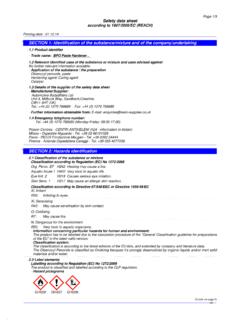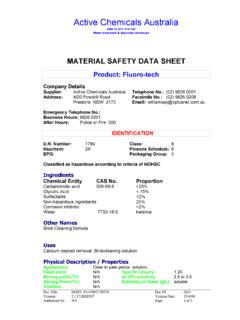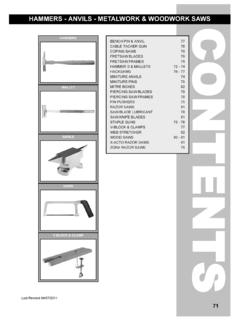Transcription of Material Safety Data Sheet - fibreglass repair, resin ...
1 Material Safety data Sheet Date prepared: 01/07/2003 Date revised: No 3 GENERAL PURPOSE EPOXY resin ABL (STEVENS) resin & Glass Unit 4, Millbuck Way, Springvale Industrial Estate, Sandbach, Cheshire, CW11 3HT Tel/Fax: 01270 766685 1. Identification of the product and the company. Substance or preparation trade name: GENERAL PURPOSE EPOXY resin Unique reference numbers(s): Company/undertaking name & address: As above Telephone: 01270 766685 Emergency telephone number: 2. Information on ingredients Substance Name Value CAS No Symbol R-Phrases ---------------------------------------- ---------------------------------------- ---------------------------------------- Epoxy resin <70% 25068-38-6 R36/38-43-51/53 Bisphenol F.
2 Epichlorohydrin resin <30% 28064-14-4 R36/38-43-51/53 Aliphatic glycidylether <15% 68081-84-5 Xi,N R36/38-43-51/53 3. Hazards Identification Risk phrases: Irritating to eyes and skin. May cause sensitization by skin contact Environmental hazard: Toxic to aquatic organisms, may cause long term adverse effects in the aquatic environment. Other hazards: Not classified as flammable but will burn.
3 4. First aid measures Inhalation: No specific measures. Skin contact: DO NOT DELAY Remove all contaminated clothes and footwear immediately unless stuck to skin. Drench the affected skin with running water for 10 minutes or longer if substance is still on skin. Transfer to hospital if there are burns or symptoms of poisoning. Eye contact: DO NOT DELAY Bathe the eye with running water for 15 minutes. Transfer to hospital for specialist examination. Ingestion: DO NOT induce vomiting. If conscious, give 1 pint water to drink immediately. If unconscious and breathing is OK, place in recovery [position. Transfer to hospital as soon as possible. 5. Fire fighting measures - 1 - Material Safety data Sheet Date prepared: 01/07/2003 Date revised: No 3 Suitable extinguishing media: Foam.]
4 Water spray or fog, Unsuitable extinguishing media is water jet. Use water spray to cool containers. Surrounding fires: Use water spray or fog for cooling exposed containers. Protection against fire: Do not enter fire area without proper protection. Respiratory protection equipment may be necessary. Special procedures: Exercise caution when fighting any chemical fire Avoid (reject) fire fighting water to enter environment.
5 Exposure hazards: Not classified as flammable but wil burn. Carbon monoxide may evolve if incomplete combustion occurs. 6. Accidental release measures Personal precautions: Equip cleanup crew with proper protection. Respiratory protection equipment may be necessary Environmental precautions: contain spillage using bunding. Do not discharge into drains or rivers. Do not contaminate surface water avoid subsoil penetration. If Material enters drains it should be pumped out into an open vessel, emergency services should be called to assist in this operation.
6 Methods for cleaning: Absorb into dry earth or sand, transfer to a closable, labeled container for disposal by appropriate method. Scrub contaminated waste. Put leaking containers in a labeled drum or overdrum. Refer to section 13 of SDS for suitable method of disposal. 7. Handling and storage Precautions in handling and storage: Both local exhaust and general room ventilation are usually required. Storage: Store in dry well ventilated areas. Handling: Handle in accordance with good industrial hygiene and Safety procedures. Ensure prompt removal from skin eyes and clothing. Wash hands and other exposed areas with mild soap and water before eat, drink or smoke and when leaving work.
7 Pallatised loads should be stacked to maximum of 4 high. 8. Exposure Controls / Personal protection Personal protection: Respiratory protection: No special respiratory protection equipment is recommended under normal conditions of use with adequate ventilation. Skin protection: Protective gloves, Nitrile or Butyl. Eye protection: Safety glasses and suitable eyewash bottle with clean water.
8 Ingestion: When using, do not eat drink or smoke. 9. Physical and chemical properties Appearance: Liquid Colour: Pale yellow Odour: Perceptible odour Oxidising: Non oxidising Soliability in water: mg/l @ 20 C Boiling point: 150 C Viscosity: : 25 C ASTM D-445 Autoflammability: ca 400 C Flash point ( C): >150 Vapour pressure: < mbar @ 20 C Relative density.
9 @ 20 C 10. Stability and reactivity Stability: stable under normal conditions. Conditions to avoid: Caustic soda can induce vigorous polymerization at temperatures around 200 C Materials to avoid: Strong oxidizing agents. Haz decomp products: Hazardous decomposition products are not expected to form during normal storage. Polymerises exothermically with amines, mercaptans and Lewis acids at ambient temperature and - 2 - Material Safety data Sheet Date prepared: 01/07/2003 Date revised: No 3 above polymerises in contact with caustic soda.
10 Reacts exothermically with bases, ammonia, primary and secondry amines, alcohols and acids. 11. Toxicological information Routes of exposure: Eye skin irritation expected to be slightly irritant and skin sensitizer, Not expected to be mutagenic hazard. 12. Ecological information Mobility: Sinks in water Persistence and degradability: Not Biodegradable Bioccumulative potential: Bioccumulation potential Other adverse effects: Harmful to aquatic organisms. 13 Disposal Considerations Disposal: Avoid release to the environment.










